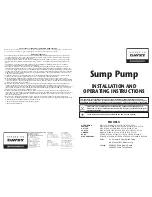
Installation and Operation Manual
SA-07-11-87, Rev A
51
January 2019
Situation/Symptom
Possible Cause
Investigative/Corrective Action
Insufficient total
head
cont.
NPSH
actually
lower
than
NPSH
requirement listed on specification sheet.
Refer to solutions listed under “No
flow, no pressure at start-up”.
Flow too low, causing overheating of fluid
resulting in internal boiling and unstable
pump operation.
Increase through-flow rate.
Bypass part of pump discharge to
supply tank.
Diffuser discharge throat partially plugged or
impeller damaged by passage of a solid
particle.
Clean these areas of all obstructions
and restore surfaces to a smooth
polished finish free of all corrosion
pitting. Edge of diffuser throat must be
sharp.
Corrosion and/or erosion of diffuser throat
(may also be accompanied by corrosion/
erosion of diffuser and cover surface
adjacent to impeller).
If edge of throat is no longer sharp and
smooth or has opened in size, head-
rise may be reduced. Opening of the
inlet area of the throat will result in
higher flow rate and horsepower
consumption. Corrosion/erosion of
diffuser and cover surfaces will result
in a significant horsepower increase.
Excessive recirculation from discharge to
inlet.
Check flow through external plumbing.
Pump o-ring (936C) damaged or
missing.
Integral centrifugal separator orifice
worn.
Process fluid specific gravity or viscosity
different from values shown on specification
sheet.
Check actual viscosity and specific
gravity at operating temperature.
Viscosity higher than five centipoise
will cause reduced head and flow and
increased power consumption.
Driver speed too low.
Check speed against value listed on
specification sheet.
Pressure gauges or flow meters in error
Calibrate instrumentation.
Driver overloaded.
Fluid specific gravity or viscosity higher than
values listed on specification sheet.
Check actual viscosity and specific
gravity
against
value
listed
on
specification sheet.
Electrical failure in electric driver.
Check circuit breaker heater size and
setting.
Check voltage and voltage balance
between phases.
Current for each phase should be
balanced within three percent.









































